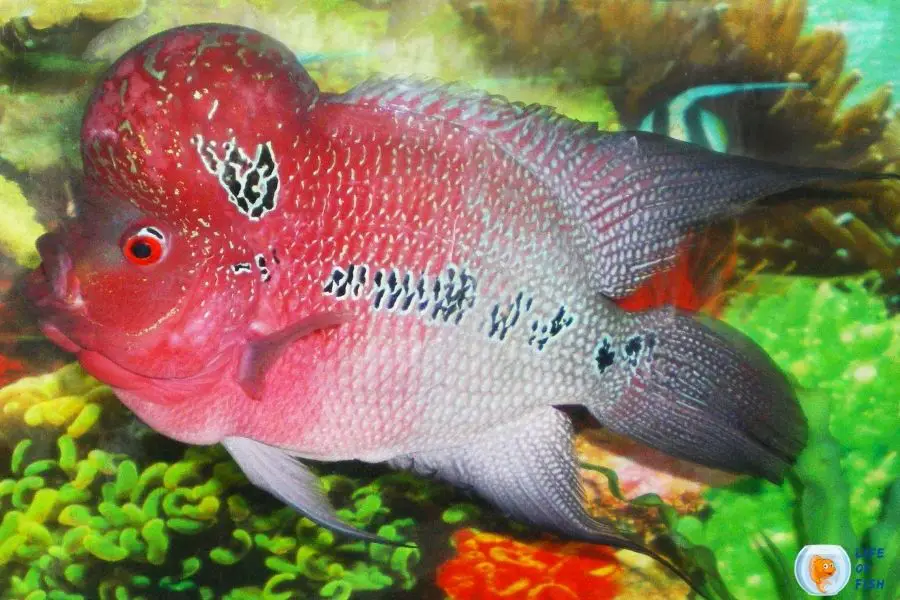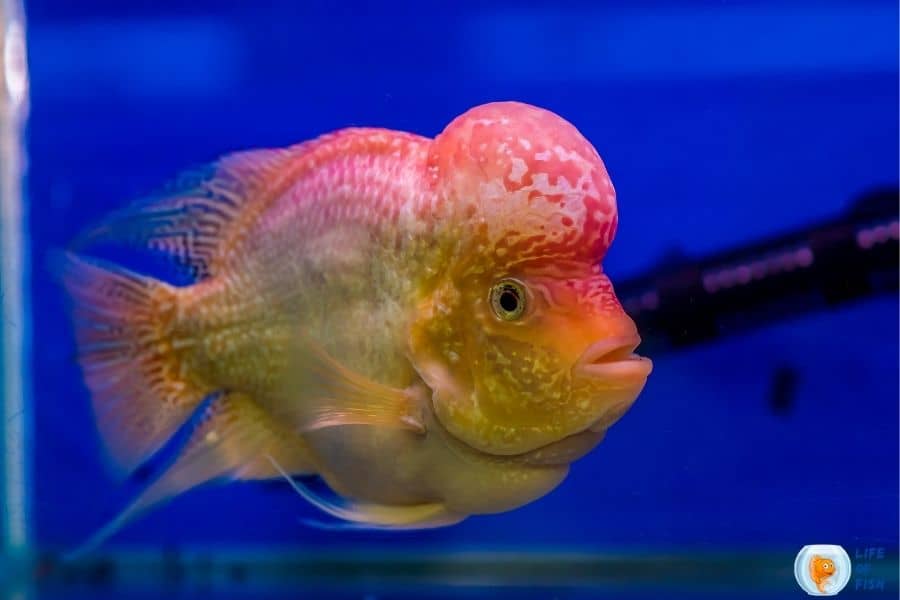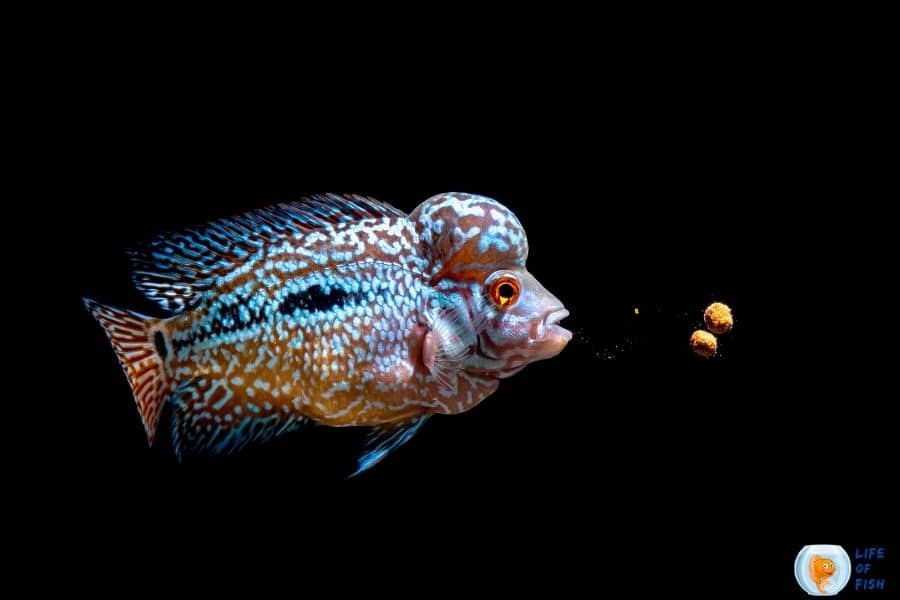Kamfa flowerhorns are one of the most popular flowerhorn cichlids. They are known for their bright colors and impressive size.
While they can be somewhat difficult to care for, they are definitely worth the effort if you’re looking for an interesting fish to keep in your aquarium.
If you’re thinking about adding a kamfa flowerhorn to your tank, there are things you should know beforehand. This article is to help you with some basic information on Kamfa flowerhorn care.

What is kamfa flowerhorn?
Jump To
- 1 What is kamfa flowerhorn?
- 2 What Makes a Flowerhorn a Kamfa?
- 3 What size does Kamfa Flowerhorn Get?
- 4 What is king kamfa flowerhorn?
- 5 Is kamfa flowerhorn aggressive?
- 6 Kamfa flowerhorn behavior
- 7 What is the lifespan of a kamfa flowerhorn?
- 8 One look care guide
- 9 Kamfa flowerhorn care
- 10 Kamfa flowerhorn breeding
- 11 How to feed the kamfa flowerhorn?
- 12 What fish can live with the kamfa flowerhorn?
- 13 Conclusion
It is believed that the flowerhorn is a hybrid species of Mesoamerican cichlid hybrids. However, no one knows which species have been used to create flowerhorns.
Since this is a man-made hybrid species, there are several varieties of flowerhorns. They are one such species with distinctive characteristics.
Certain traits of these fish make them more desirable than other flowerhorn species. Because of their popularity, kamfa flowerhorn are often bred for ornamental purposes in captivity.
What Makes a Flowerhorn a Kamfa?
When a flowerhorn possesses more than 75% of “Kamfa traits,” it is called a “Kamfa Flowerhorn.” Kamfa traits are:
Nuchal hump – This is a fleshy lump on the back of the fish’s head that is often more pronounced in kamfas.
Square body – A kamfa’s body is more square-shaped when viewed from the side, while Zhen zhus are more tapered.
Smaller, Round lips – A kamfa should have smaller and rounder lips than other flowerhorn varieties. Especially, Zhen zhu lips are pointer than Kamfas. This is the main characteristic of Kamfa flowerhorns.
No underbite or overbite – Underbite and overbite are traits of Zhen zhus. They do not have any underbite or overbite.
Short and wrapped fins – This is one of the main characteristics of Kama flowerhorns. The fins should be strong, wrapped, and short. The fins of Zhen zhus are long and trailing fins, while Kamfas wrap their fins around the caudal fins.
Strong fins – The fins of them are stronger than Zhen zhu varieties. This trait is distinct in high-quality Kamfas.
Strong caudal fins – The caudal fins of Kamfas are stronger than Zhen zhus. They have an upright tail, while Zhen zhus have a drooping tail.
Excellent pearl coverage – This is another main trait of Kamfa flowerhorns. They should have good pearl coverage on their body.
While many other traits can be used to identify a kamfa, these are the most common and reliable.
What size does Kamfa Flowerhorn Get?
They can grow up to 16 inches in length. However, the most common size is about 12 inches.
What is king kamfa flowerhorn?
King Kamfa is the variety that has most of the above-mentioned “Kamfa Traits” and is the most popular one as it has more distinct colors and has fewer defects.
Is kamfa flowerhorn aggressive?
Yes. They are hybrid of aggressive cichlid species like Red Devil Cichlids, Green Texas Cichlids, and Midas Cichlids.
These cichlid varieties are the most aggressive species, and therefore, Kamfas share the same characteristics.
They are more aggressive toward peaceful and smaller-sized fish. Consequently, it is not recommended to house any fish smaller than 10 inches long with Kamfa flowerhorns as they do not stand a chance to compete with these fish.
Kamfa flowerhorn behavior
They are very active fish and like to move around a lot. They are also known to be very territorial and aggressive toward other fish.
However, they are known to be social around their owners. You can even train your Kamfa flowerhorn to do tricks.
What is the lifespan of a kamfa flowerhorn?
They can live up to 10 years, but the average lifespan is about 5-7 years.
One look care guide
| Scientific name | N/A |
| Common name | Kamfa flowerhorn |
| Care level | Easy |
| Native to | Captive-bred |
| Type | Tropical freshwater fish |
| Color | Varies |
| Tank size | 125 gallons minimum |
| Preferred temperature | 80-85°F |
| Other water parameters | pH: 7.4-8.0 Alkalinity: 6°-20° dGH |
| Preferred salinity | No salinity |
| Size | 12 inches |
| Life span | Ten years |
| Temperament | Aggressive |
| Recommended tank mates | Other cichlids (especially other flowerhorn varieties) Angelfish Gouramis Sailfin pleco Common pleco Smaller Arowana species Tiger Oscars Large Bichirs |
| Preferred food | live food Frozen food Flake food |
| Feeding frequency | Three times per day |
| Breeding | Difficult Crossbreeding is needed Mouthbrooders |
Kamfa flowerhorn care
Taking care of flowerhorns is easy when it comes to tank conditions. You need to provide a big enough tank with some decorations and other necessary equipment.
But, the aggressive behavior of these fish limits the choices of tank mates. As a result, when it comes to selecting tank mates for your Kamfa flowerhorn, you are at a disadvantage.
Kamfa flowerhorn size
When Kamfa flowerhorns are first born, they are only about 1-2 inches long. They will grow to their full size of about 12 inches in about one year.
Kamfa flowerhorn tank size
Because of their large size, Kamfa flowerhorns require a tank of at least 125 gallons in size. If you plan on housing a pair of Kamfa flowerhorns, the tank size should increase to about 150 to 175 gallons.
How many kamfa flowerhorn should be kept together?
Pairing Kamfa flowerhorns should only be done if you have a large tank size of at least 150 to 175 gallons.
If you do not have a large enough tank, you can keep only one Kamfa flowerhorn in the tank. Otherwise, they will fight to the death.
Further, you can only keep a male and a female specimen in one tank. Since flowerhorns are highly territorial, two males or two females will not get along.
Tank setup
Flowerhorn cichlids require a massive tank in order to thrive. If you can provide a large enough space, these fish make for interesting aquarium inhabitants.
You should decorate the tank with rocks and plants to provide hiding places and territory. Flowerhorn cichlids are aggressive and territorial, so you should offer plenty of space for each fish. A minimum tank size of 125 gallons is suggested.
Substrate
Even though the most popular choice for aquariums is gravel, it is not wise for flowerhorns as they may swallow them with their food.
So, there is a risk of blocking their intestines. Sand is a much better choice for substrate as it does not get ingested.
Java moss can also be used as a substrate. Other popular choices for flowerhorn tanks are bare bottom and large pieces of tiles as the substrate.
Decorations
If you add decorations to your flowerhorn tank, your fish will be less interactive with you and other tankmates.
So, most fish keepers prefer to keep flowerhorns in bare tanks as they prefer the interaction of their fish.
If you want a (kind of) peaceful flowerhorn, you can add some decorations such as driftwood and caves to minimize their aggressive behavior. Either way, flowerhorns will be fine if they get enough space to secure their territory.
Lighting
Kamfa flowerhorns are not demanding when it comes to lighting. A regular fluorescent light will work just fine. You should keep the duration of light exposure between 10 and 12 hours per day.
Temperature
The ideal temperature for a Kamfa flowerhorn tank is between 80 and 85 degrees Fahrenheit. Since they need a temperate climate in their surroundings, you need to add a heater to your tank.
Filtration
Flowerhorn tanks require powerful filters as they are messy eaters. A Cannister filter that can handle a tank size of 125 gallons or more is recommended.
Water flow
Kamfa flowerhorns are strong fish with strong fins that can handle moderate to high water flow. So, you can add a few powerheads to your tank if you prefer. Adding powerheads will also help to push the waste toward the filters.
Tank lid
Flowerhorns are known jumpers. So, you need to make sure that you have a tight-fitting tank lid to avoid them jumping out of the tank.
Water quality condition
Since flowerhorns are a hybrid of several cichlid species that live in a wide range of water parameters, these fish can tolerate a wide range of water conditions.
However, you should still try to maintain the water quality in your tank by doing regular water changes.
The ideal water parameters for Kamfa flowerhorns are,
- Temperature: 80-85°F
- pH: 7.4-8.0
- Alkalinity: 6°-20° dGH
Keep in mind that flowerhorns can survive in slightly different water conditions. But, the conditions must be stable and not fluctuate.
These fish are sensitive to poor water conditions. You must maintain zero Ammonia, Nitrate, and Nitrite levels in your tank. Further, you should remove about 25% water weekly and replace it with dechlorinated water.

Kamfa flowerhorn breeding
Breeding Kamfa flowerhorn is not simple as breeding other types of cichlids. As this is a hybrid species, most kamfa flowerhorns are infertile. Males are known to be more infertile than females.
Most aquarists try to breed these fish as they are magnificent fish that cost high. But, most fail because of the infertility of these fish.
You can, however, try breeding female Kamfa flowerhorns with another cichlid species. Mos preferred cichlid species are those who have a genetic background of Flowerhorns.
In this case, you may not get a Kamfa flowerhorn offspring but another variety of flowerhorns.
Kamfa flowerhorn male or female identification
It is not easy to distinguish the male and female Kamfa flowerhorn fish. However, most people believe that the male has a more concave forehead while the female has a more convex forehead.
The male is also known to be larger and has a longer dorsal fin than the female. They also have bright and more vivid colors than the females.
So, if you plan to buy a Kamfa flowerhorn, make sure that you ask the seller to identify the gender of the fish before you purchase it. This will help ensure that you are getting the correct sex of fish.
Identify pregnant kamfa flowerhorn and kamfa flowerhorn pregnancy stages
It is not easy to distinguish pregnant flowerhorns from the other fish. However, when the female flowerhorn is pregnant, it becomes more aggressive and territorial.
It will reject food for some days. The stomach will also become round, and the body will become fatter.
The female flowerhorn usually drops her eggs in a pre-selected spot. She will then take care of the eggs until they hatch. The eggs usually hatch within 72 hours.
The mother does not help in any way to take care of the eggs or the fry. In fact, she may even eat the eggs or fries. So, it is essential to remove the mother from the tank when you see her dropping her eggs.
Kamfa flowerhorn breeding
As we mentioned above, it is impossible to breed a pair of Kamfa flowerhorns. To breed Kamfa flowerhorns, you must pair a female Kamfa flowerhorn with another fertile cichlid species.
In a rare occurrence, there will be fertile males. If you happen to have a fertile male Kamfa, consider yourself lucky.
The breeding tank should have bare minimum equipment and decorations. A sand bottom or a bare bottom is preferred with a sponge filter.
The breeding process is the same as breeding other cichlids. The female will lay her eggs, and the father will fertilize them. The eggs will then hatch, and the parents will raise the fry.
In most cases, the female Kamfa flowerhorn will not produce eggs if she is not paired with a fertile cichlid. So, it is vital that you select the right mate for your fish before attempting to breed them.
How many babies do kamfa flowerhorn have?
Kamfa flowerhorns can lay about 500 to 2000 eggs. However, the female will not lay eggs in most cases if she is not paired with a fertile cichlid.
Kamfa flowerhorn fry care
As these fish become aggressive after breeding, moving the parents to their home tanks a few days after eggs hatch is better. Otherwise, the fights between the adult fish may cause harm to the fry.
The flowerhorn fry will need to be fed a high-protein diet for the first two months. After that, you can start feeding them a diet that consists of flake food and live foods.
The fry can be raised in a community tank, but make sure that the other fish in the tank are not aggressive.
The fry will need to be separated from the other fish when they start to grow and become more aggressive.
How to feed the kamfa flowerhorn?
Like their parent species, flowerhorns are omnivore fish that will accept any food you offer. However, it is essential to feed them with a high protein diet to keep their health and coloration.
You can feed them a diet that consists of live food, frozen food, and flake food. However, be careful not to overfeed them since this might lead to health issues.
Feeding your fish three times per day should be enough. However, you can adjust the number of feeding based on the size and age of your fish.
As these fish are voracious eaters, feeding an amount they can eat within 20 to 40 seconds is ideal.

What fish can live with the kamfa flowerhorn?
Due to their size and aggressive nature, Kamfa flowerhorns are better kept alone or in a species-only tank.
If you plan to keep more than one fish, be sure that you add only one pair of fish per tank. The other fish should be docile and of similar size.
Some good tank mates for Kamfa flowerhorns include:
- Other cichlids (especially other flowerhorn varieties)
- Angelfish
- Gouramis
- Sailfin pleco
- Common pleco
- Smaller Arowana species
- Tiger Oscars
- Large Bichirs
You should avoid any fish smaller than 10 inches long as they may get eaten by the Kamfa flowerhorn.
You should also avoid adding any invertebrates to the tank as they may get eaten by the fish.
Conclusion
If you prefer to add some color to your tank, then the Kamfa flowerhorn is your fish. These fish are beautiful and come in a variety of colors.
However, they are also aggressive and require a lot of space. So, if you can not take on the challenge, you should not purchase a Kamfa flowerhorn.
Read Next : Bichir Care | A Distant Cousin Of Dragons |
